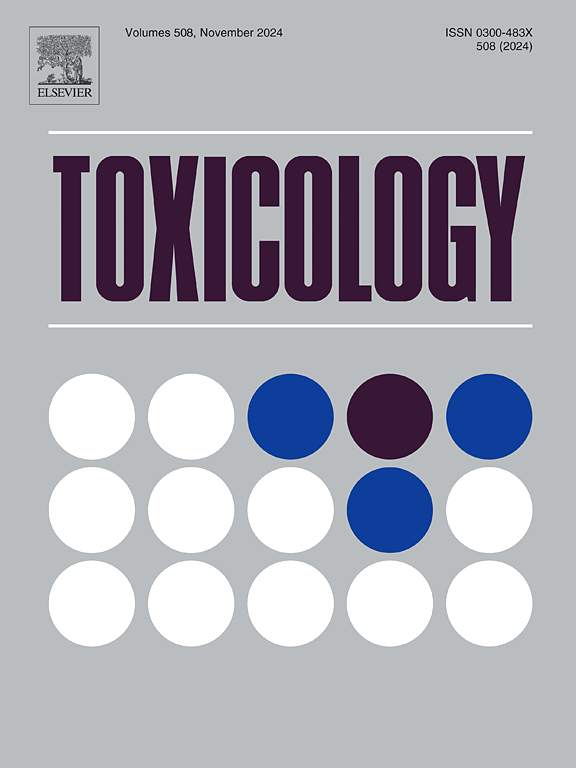Cadmium treatment induces oxidative damage and apoptosis in vitro skeletal muscle cells
IF 4.8
3区 医学
Q1 PHARMACOLOGY & PHARMACY
引用次数: 0
Abstract
Cadmium is a prevalent environmental contaminant, and current research indicates that exposure to cadmium is a significant risk factor contributing to the increased incidence of sarcopenia. However, the precise mechanisms by which cadmium exposure leads to skeletal muscle damage remain to be fully elucidated. Utilizing an in vitro culture model of mouse C2C12 myoblasts, this study exposed cells to 0, 2, 4, and 8 μmol/L cadmium chloride for 24 hours to evaluate the cellular damage and explore the potential mechanisms. Our present data of this study demonstrate that cadmium treatment results in a reduction of C2C12 cell viability, an increased release of lactate dehydrogenase, and an imbalance in the oxidative-antioxidant system characterized by an excessive accumulation of reactive oxygen species, elevated malondialdehyde production, and decreased superoxide dismutase activity. Additionally, there is an upregulation of nuclear factor-erythroid 2-related factor 2, heme oxygenase-1, NAD(P)H quinone oxidoreductase 1, and glutamate-cysteine ligase catalytic subunit protein expression, along with a downregulation of superoxide dismutase 1 protein expression. Furthermore, cadmium exposure mediates an increase in cysteinyl aspartate specific proteinase-dependent apoptosis via the mitochondrial pathway, as indicated by an increased apoptosis rate, elevated Bcl-2 associated X protein and cysteinyl aspartate specific proteinase 3 protein expression, and a decreased expression of B-cell lymphoma-2 protein. Our findings elucidate the mechanisms of cadmium-induced cytotoxic damage in skeletal muscle cells from the perspectives of oxidative injury and apoptosis, thereby providing a theoretical basis for the prevention and treatment of cadmium toxicity.
镉处理诱导体外骨骼肌细胞氧化损伤和细胞凋亡
镉是一种普遍存在的环境污染物,目前的研究表明,接触镉是导致肌肉减少症发病率增加的一个重要危险因素。然而,镉暴露导致骨骼肌损伤的确切机制仍有待充分阐明。本研究利用小鼠C2C12成肌细胞体外培养模型,将细胞暴露于0、2、4和8 μmol/L的氯化镉中24 h,观察细胞损伤情况并探讨可能的机制。我们目前的研究数据表明,镉处理导致C2C12细胞活力降低,乳酸脱氢酶释放增加,氧化-抗氧化系统失衡,其特征是活性氧过度积累,丙二醛产量升高,超氧化物歧化酶活性降低。核因子-红细胞2相关因子2、血红素加氧酶1、NAD(P)H醌氧化还原酶1、谷氨酸-半胱氨酸连接酶催化亚基蛋白表达上调,超氧化物歧化酶1蛋白表达下调。此外,镉暴露通过线粒体途径介导半胱氨酸天冬氨酸特异性蛋白酶依赖的凋亡增加,凋亡率增加,Bcl-2相关X蛋白和半胱氨酸天冬氨酸特异性蛋白酶3蛋白表达升高,b细胞淋巴瘤-2蛋白表达降低。我们的研究结果从氧化损伤和细胞凋亡的角度阐明了镉诱导骨骼肌细胞毒性损伤的机制,从而为镉毒性的预防和治疗提供了理论依据。
本文章由计算机程序翻译,如有差异,请以英文原文为准。
求助全文
约1分钟内获得全文
求助全文
来源期刊

Toxicology
医学-毒理学
CiteScore
7.80
自引率
4.40%
发文量
222
审稿时长
23 days
期刊介绍:
Toxicology is an international, peer-reviewed journal that publishes only the highest quality original scientific research and critical reviews describing hypothesis-based investigations into mechanisms of toxicity associated with exposures to xenobiotic chemicals, particularly as it relates to human health. In this respect "mechanisms" is defined on both the macro (e.g. physiological, biological, kinetic, species, sex, etc.) and molecular (genomic, transcriptomic, metabolic, etc.) scale. Emphasis is placed on findings that identify novel hazards and that can be extrapolated to exposures and mechanisms that are relevant to estimating human risk. Toxicology also publishes brief communications, personal commentaries and opinion articles, as well as concise expert reviews on contemporary topics. All research and review articles published in Toxicology are subject to rigorous peer review. Authors are asked to contact the Editor-in-Chief prior to submitting review articles or commentaries for consideration for publication in Toxicology.
 求助内容:
求助内容: 应助结果提醒方式:
应助结果提醒方式:


